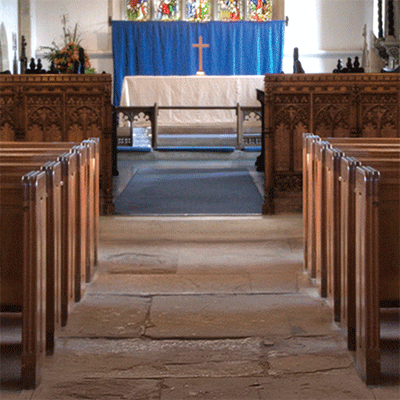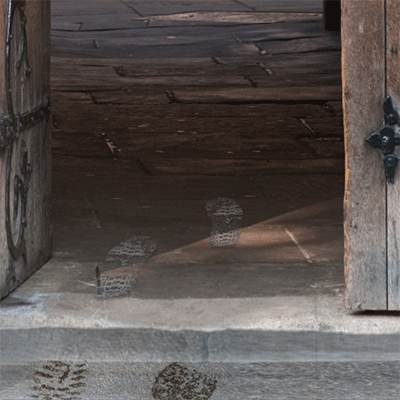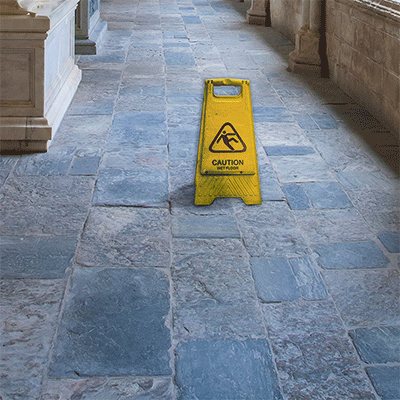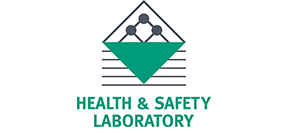Slips and trips in churches
07 September 2022
Our data tells us that slips and trips are the most common causes of injury in churches. Most are minor, however others can be quite severe and sometimes even disabling.
Slips and trips account for over a third of liability claims1 and hazards are not only present inside the church itself. They are also common outside it – in church halls, churchyards, burial grounds and car parks. Frequently, these can be compounded by the difficulty the frail, elderly and disabled may have in negotiating access to and from the church.
Scroll down to view our church slips and trips video which identifies some common hazards in churches.
Older, historic churches
A historic church may present different hazards to a modern building, such as uneven floors or poor lighting, and can challenge the standard approaches to preventing slips and trips. This is usually due to the historic fabric of the building or design constraints. As a consequence, trying to identify and implement suitable precautions can be problematic.
To help, we teamed up with leading researchers at the Health and Safety Laboratory (HSL) to produce specific guidance in this area. The guide is in eight parts and considers the most significant risk factors, outlining cost-effective, yet sympathetic solutions which can preserve church buildings as well as protect congregations, volunteers and visitors.
You can access the practical findings of this unique research by reading more about the different risk factors via the images below, or going direct to the guidance documents listed at the bottom of this page.
The problem and the solution
 | Building designThe fabric and design of a church can be something to celebrate but might also be a risk. How do we strike the balance between protecting history and your people? - Hazard - Change in flooring type and level where this presents a significant risk
- Solution - A carpet either side of the step (but not over it) highlights it is there.
Find out more about building design |
 | Inspection and maintenance of floors etc.An effective approach to the inspection and maintenance of floors, steps and paths is important in preventing slips and trips. Keeping simple records of this can also help to protect you should a claim be made. - Hazard - Broken paving
- Solution - After inspection, fence it off.
Find out more about inspection and maintenance |
 | The environment and contaminationThere are a number of factors that can affect how likely people are to slip. The most important of these include lighting levels (that can influence how easily people will spot hazards); adverse weather conditions (such as snow or ice affecting underfoot conditions); and contamination (anything on the floor surface that can make it more slippery). - Hazard - Wet weather being walked inside
- Solution - At entrances, add matting of the correct size and position carefully.
More about the environment and contamination |
 | CleaningMany slip and trip hazards can be eliminated in churches with proper cleaning and good housekeeping. It is easy to get this wrong or ignore it completely, and it is not always viewed as a safety critical activity. Poor cleaning can leave smooth floors wet and bad housekeeping can introduce additional hazards. - Hazard - A warning sign left in place after the floor has dried.
- Solution - Ensure staff/volunteers know to remove the sign as soon as the floor is safe.
More about cleaning hazards |
 | PeopleHow people access and use your church can increase the risk of slipping or tripping. This isn't just during normal, day-to-day activities, but also during other events. Understanding this can help identify slip and trip hazards. Sharing information about slip and trip hazards with staff/volunteers and visitors can also help to reduce the chance of them happening. - Hazard - A staircase that is difficult for someone with a physical disability to use
- Solution - Present a short video about the spaces that cannot be accessed.
More about people hazards |
Watch our short video to learn more about slips and trips and the precautions you can take at your church.
Preventing slips and trips
You are probably already taking a number of precautions to protect those who use the church from slips and trips. In many instances, straightforward precautions can make a real difference; for example, making sure spillages are cleaned up promptly so people do not slip, or there are no trailing electrical cables presenting a trip hazard.
In some situations you may need to:
- Complete a risk assessment if you are an employer to identify the precautions you need to take
- Implement adequate precautions, providing information and training for any employees and volunteers on what they need to do
- Make periodic checks that your precautions remain adequate
- Document your arrangements and responsibilities for preventing slips and trips, perhaps as part of your health and safety policy
- Keep records of what you have done.
It’s also important to consider the prevention of slips and trips in graveyards and burial grounds too, as this is an often-frequented area of the church – whether walking into the church to attend a service or accessing the grounds for funerals.
General information on managing the risk from slips and trips is set out in our guidance note below including the actions you can take. More detailed information about controlling specific risk factors is provided in the guidance produced in collaboration with the HSL.






